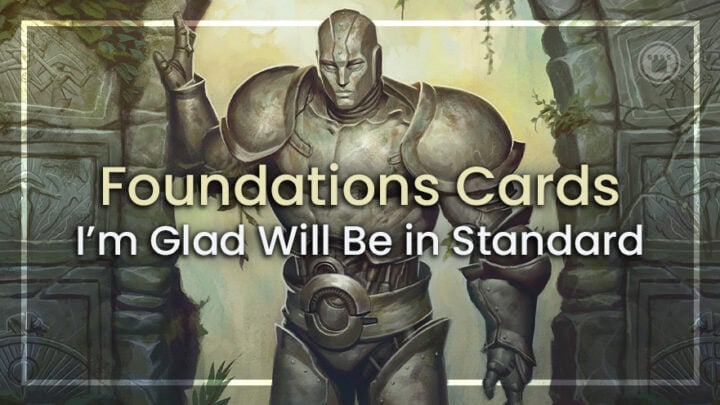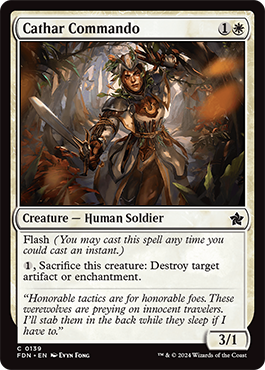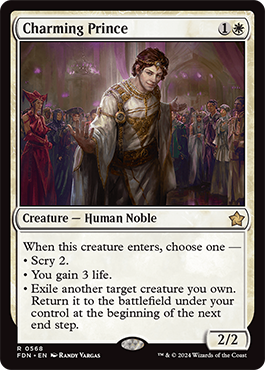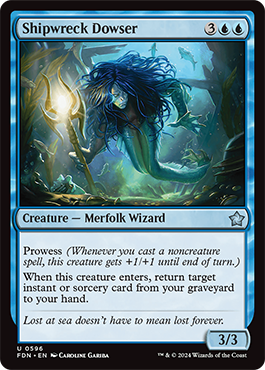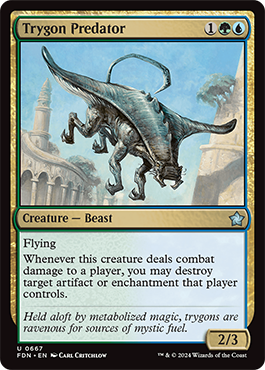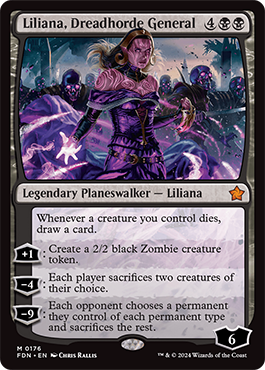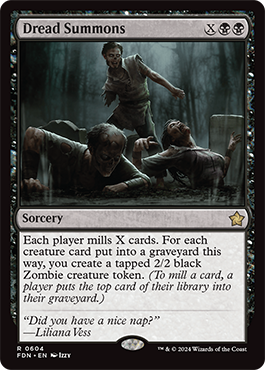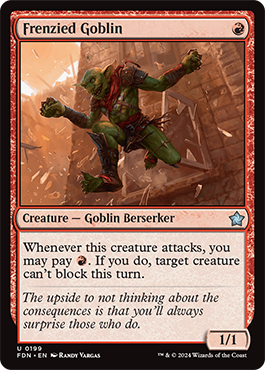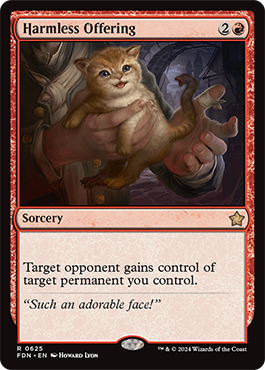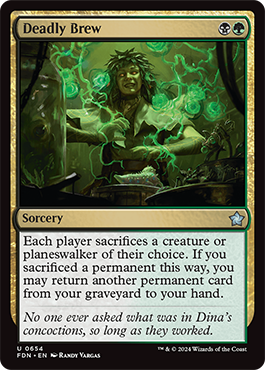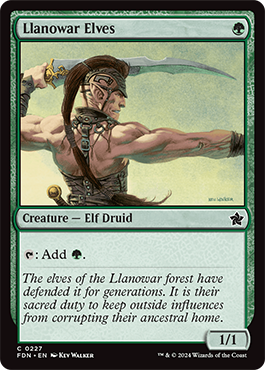If we’re only to judge by the historical facts, Magic isn’t really sure if it likes having core sets. Nevertheless, it’s about to try and have one again for the first time in several years.
Foundations is different in some ways from the classic core sets. It’s got more new cards than reprints, and looks to be a lot more bold in featuring complex or synergy-driven effects. But the most important thing about core sets, this one included, is the commitment they represent – a stable, non-rotating “foundation” for Standard play.
Wizards have promised that this set will remain legal for the rest of the decade, which even in context of past core sets is a lofty goal. That’s twice as long as Sheoldred, the Apocalypse’s tenure – and she feels like she’s been here forever. So, even the newest, weirdest Foundations cards are going to feel like old familiar friends by the time they finally leave Standard in 2029. But in this first, uncertain encounter I find my eyes drawn to the known quantities: the reprint cards that Wizards believes in as the new core of our Standard experience.
WHITE
Cathar Commando
One of my favorite white cards in the last few years – and if you’re a fellow white mage then you know that’s a crowded field!
It may only be a role-player at best, but the Commando offers essential utility (noncreature permanent removal) at a deckbuilding cost so low it’s more like a deckbuilding credit. A 3 power flash blocker is also a removal spell for attacking creatures in all but name – and if your opponent spends resources to try and save their guy, you can still activate the Commando against any legal target to come out ahead.
In control matchups, the high power and flash are equally valuable for complicating opposing sequencing on early turns, where those minor differences have the most impact. And of course, it’s a valuable hedge against board wipes, helping you play around those match-turning spells without completely sacrificing your tempo. The fact it can undo the best current Standard sweeper (Temporary Lockdown) is just another feather in this Cathar’s fancy hat.
Charming Prince
This noble is another amazing enabler for white decks of all stripes, making it a perfect Core Set type of card. Even if getting decent card selection in white is not as revelatory now as it was back in Eldraine, this is still a fine way to invest mana in your board that can help you to either survive, stabilize, or take charge of your current situation.
Plus – not that I expect it to come up necessarily – but the targeting on the Prince’s flicker clause is about as loose as these things ever get, merely requiring “another creature you own”. So there’s better than coin flip odds that at some point there will be some moderately-viable combo deck based on looping these, which would make me very happy.
BLUE
Shipwreck Dowser
I know I’m not the only veteran of M19 Limited who was crowing to see this card make a comeback! Nostalgia and Draft impact aside, the Dowser’s ability to recur spells on ETB fills an important niche in the brewer’s arsenal of Standard.
Whether you’re looping the Dowser and a reanimation spell in and out of your graveyard, or flickering it with some other effect to repeatedly buy back useful spells, the potential applications are limited only by your imagination (and speaking realistically, its mana cost).
Self-Reflection
A more recent favorite and prime candidate for Shipwreck Dowser synergy, Self-Reflection is a very well-judged secondary effect that will be useful to both combo decks and fair grave-centric lists.
A context-dependent late-game haymaker like this is the ideal card to have a cheap flashback cost on. In deckbuilding, Self-Reflection helps incentivize self-mill as a form of card selection and the inclusion of large, non-legendary creatures, both things I’m a fan of.
Best of all, it’s highly splashable. I cannot wait to once again control multiple Terror of the Peaks tokens in Standard!
Trygon Predator
I admit this one is partially a nostalgia beat for me – I fell in love with Magic through the original Ravnica sets and this dumpy little monster was always one of the card arts which stuck out to me in that crowded block. As I grew older and wiser in the game, I came to also appreciate Trygon’s unlikely role as (then) Standard staple, primarily to threaten enemy signets.
Standard may not have ubiquitous two-mana rocks for this Predator to prey upon anymore, but it does have a very significant number of Talents and other valuable artifact and enchantment engines which will make Trygon feel highly justified – so long as it survives to hit face.
BLACK
Liliana, Dreadhorde General
Black’s position in Standard has hovered somewhere between “very good” and “dominant” for the past couple of years, so I did think twice about celebrating the reintroduction of another potent, versatile black tentpole. The Dreadhorde General may have spawned relatively healthy play patterns back in War of the Spark, but should that draw trigger really get to co-exist with Sheoldred, the Apocalypse?
Ultimately, I decided I still like this card – it’s as fair and interesting a six-mana planeswalker as you’re going to get, both to play with and against. Six mana also feels like so much more now than it did even at the time, and it will be interesting to see if even this version of Liliana can entice people to build their black decks differently when Unholy Annex and Archfiend of the Dross are running around.
Dread Summons
One of the things Core Sets can be really good for is locking in some niche enabler effects; the kind of card which is often required to support some inventive brew, but is unusual enough that it sometimes won’t be legal in the format when you look for it. For example, the last few years have featured plenty of graveyard sets (Duskmourn, The Brothers’ War, Midnight Hunt & Crimson Vow) and a lot of payoffs that could reward aggressive self-mill – but hardly any ways to actually mill yourself significant amounts while staying mana-efficient in what is theoretically an aggro deck.
Duskmourn has gone some way towards helping this issue, but Dread Summons looks like a more definitive solution – one that immediately slots into such decks as your best way to load the yard while still adding to the board. If you’re one of the graveyard scientists trying to make Urborg Lhurgoyf and friends work, then this is your chase card for the set.
RED
Frenzied Goblin
I think it’s neat that Foundations is making an effort to fit in iconic creature types of each color as significant themes: there are certainly worse ideas for growing the game than ensuring it’s always legal to play Goblins in Standard. The type is not really why I like Frenzied Goblin though. Rather, I see it as helping to establish an alternative style for red decks.
While it may not sound fun for a card to negate blocking (an ability which hearkens back to the Ramunap Red days of total aggro domination) I see the Goblin more as a way to spend mana effectively over many turns and reduce the need to sneak under potential defenders. Considering how burst-focused the current red deck builds are, I’m very happy to see a few effects start to balance the scales in favor of other approaches for red.
Harmless Offering
This is the other big win in the “niche enablers” column with Dread Summons. It seems to be every couple of sets we get some card where the best thing you can do with it is give it away – but how to achieve such an unusual effect that there’s only really been one clear-cut example in red recently? Answer: you put that one card in Standard forever!
Oh, and if you’re wondering what you can do with this on day one? They just went ahead and put Demonic Pact into this set as well – now you can terrorize people with that meme combo any time you like!
GREEN
Deadly Brew
I loved GB in Strixhaven Draft for its smattering of cheap, versatile, weird interactive spells, and here is one of those primary tools which made it fun!
Deadly Brew re-enters the metagame at a point where I suspect its unrestricted edict effect is going to mostly miss valuable targets – especially if Foundations gives tokens as much spotlight as it appears to. Nevertheless, two mana is perfectly on rate for a Regrowth-type effect, and if you *do* manage to manufacture a turn where you snipe a real threat with Deadly Brew while bringing back one of your own, you’ll understand why that Strixhaven draft archetype was so very entertaining!
DISHONORABLE MENTION: Llanowar Elves
I was downright shocked to see this card present in the spoilers (then I was annoyed). I am more afraid of this one-mana 1/1 elf than practically anything else slated to appear in the foundation of 2020’s Standard. Sure, Llanowar Elves isn’t going to become part of a busted infinite combo, or even improve every plausible B-tier deck with green mana in it.
But it’s still a huge difference for your format to contain a reliable one-cost mana-producing creature. I even distinctly remember that the last Wizards designers to greenlight that card (in their post-rotation followthrough Q&A) claimed that leaving Llanowar Elves in Standard was their biggest regret/mistake – the ability to skip mana curves is just so explosive that R&D became too afraid to print any more powerful three-drop cards.
I don’t really understand why that distorting effect on mana curves would be any different five years on. Especially when the efficiency with which you can spend mana on early turns is an even bigger determinant of victory now than it was then. Let’s just hope I’m wrong and that this (and all the other elf cards) turn out to be harmless distractions… because if I’m right, then we’re all in some big trouble.
INNOVATION BECOMES TRADITION
Foundations is an absolute ton of cards to get your head around, even in an age where we’re all acclimated to a constant firehose-jet of spoilers. Narrowing my focus to just the reprints is as much a way to grapple with the ungainly bulk of the set list as anything else! Still, despite their minority role in defining this new set, the reprints we can see are already proving important in shaping our expectations of this new, unfamiliar Standard era.
What is clear even from this bird’s-eye-view is that Foundations won’t just be adding staple cards to Standard – it seems to be laying out entire staple archetypes as solid cornerstones of the format. It’s an intriguing thought, and the choice of which archetypes are represented will hint at Wizards’ future plans for the color pie, mechanical complexity, and overall game balance.
But there’ll be time to immerse ourselves in that topic next week. For now, I’m choosing to take hope from what Foundations has to say about the past – and the fact that I (mostly) agree.

Tom’s fate was sealed in 7th grade when his friend lent him a pile of commons to play Magic. He quickly picked up Boros and Orzhov decks in Ravnica block and has remained a staunch white magician ever since. A fan of all Constructed formats, he enjoys studying the history of the tournament meta. He specializes in midrange decks, especially Death & Taxes and Martyr Proc. One day, he swears he will win an MCQ with Evershrike. Ask him how at @AWanderingBard, or watch him stream Magic at twitch.tv/TheWanderingBard.

